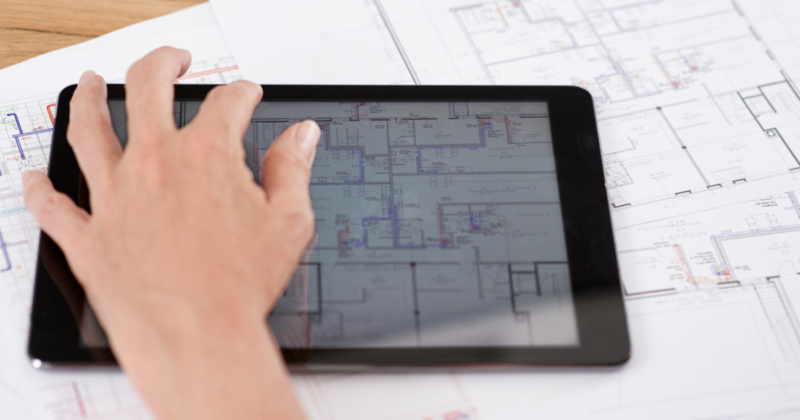 New technology is revolutionizing architectural design as well as engineering services. To remain competitive, A&E firms need to evaluate and embrace these applicable technology developments. According to a study by Deltek, “only 25% of architecture and engineering firms consider their firms digitally advanced today, but 76% expect to be there in five years.” Here are the eight most impactful technologies impacting architecture and engineering firms:
New technology is revolutionizing architectural design as well as engineering services. To remain competitive, A&E firms need to evaluate and embrace these applicable technology developments. According to a study by Deltek, “only 25% of architecture and engineering firms consider their firms digitally advanced today, but 76% expect to be there in five years.” Here are the eight most impactful technologies impacting architecture and engineering firms:
- Artificial Intelligence (AI)
- Virtual Reality (VR) & Augmented Reality (AR)
- Robotic Process Automation (RPA)
- 3D Modeling
- Cybersecurity
- Laser Scanning
- Drones
- Green Technology
1. Artificial Intelligence (AI)
As supply chain disruptions and labor shortages continue to contribute to higher inflation, businesses are looking for ways to future-proof their operations by becoming as efficient as possible. One solution that can provide efficiency—and cost-savings—is artificial intelligence (AI). Architecture and engineering firms are using AI to analyze vast datasets with speed and accuracy that human operators are simply incapable of matching. The use of AI for repetitive tasks has reduced dependency on labor during the ongoing labor shortage and has uniquely positioned the A&E industry to withstand the 13.6% increase in employee turnover.
A recent survey found 46% of projects were rescheduled due to rising costs while another 32% of respondents reported their projects were delayed indefinitely with no plan to reschedule them. The major cause of delays and concern has been the labor shortage, but AI can help perform redundant or repetitive tasks that are time-consuming for human operators which reduces reliance on a human workforce. There is significant room for growth given that 76% of surveyed firms are completely or moderately reliant on manual data entry for administrative functions.
AI also has the power to process massive amounts of data, optimize staffing levels, manage inventory efficiently, and minimize potential inefficiencies. A recent McKinsey survey revealed that 79% of all industries and activities reported cost decreases as a direct result of AI adoption and 66% of respondents even saw revenue increases.
2. Virtual Reality (VR) & Augmented Reality (AR)
Virtual reality makes it possible to perform a safety walk-through in a completely controlled and safe environment. This kind of solution comes with no risk, reduces costs associated with worker injuries, and may soon become the default for assessing hazardous situations on the job site, especially for training purposes. As much as VR/AR can seem intimidating or cost-prohibitive, 56% of surveyed firms have the same concerns preventing their adoption of the technology, but 34% of firms still expressed interest in investing in VR or AR for project execution.
Wearables supported by VR/AR technology are becoming increasingly common because they allow clients to explore rendered designs before they are built. This technology enables more informed decisions based on visuals that reduce expensive redesigns after construction has begun. Reworking designs after construction has already started can account for up to 2-20% of a project’s total contract amount. VR/AR technology also allows management or stakeholders to monitor the work site remotely and reduces the need to travel for on-site visits which is more cost-effective while also reducing their carbon footprint.
VR/AR helps promote collaboration by allowing diverse teams to work remotely and increases productivity by reducing the need to travel on site for inspections or order change approvals. Most importantly, VR and AR technology improves safety on the job by reducing the situations where human operators need to physically be present at the most hazardous job sites. Improving job safety also reduces the number of worker injury claims, which can also save costs.
3. Robotic Process Automation (RPA)
Robotic Process Automation technology is expected to grow at a rate of 16.2% annually to reach a value of $47.19 billion by 2029 according to a 2022 RPA market report. While it is still relatively new to the market, RPA is experiencing rapid adoption since it provides a supplement to manual labor during the ongoing labor shortage—much like AI. RPA can help minimize tedious tasks for the remaining human workforce, leading to increased job satisfaction and employee retention. Architecture and engineering firms that use RPA can also benefit from increased productivity and reduced costs.
Gartner predicted 85% of large organizations will have adopted RPA in some form by the end of 2022, but it is on its way to more mainstream adoption as a growing number of organizations look to cut costs amid inflation. This movement to include middle-market companies in the adoption of RPA is driven by a drop in the average price of RPA.
4. 3D Modeling
3D modeling enables architects to explore their dream designs with the ability to provide limitless project solutions and prototype models for customers. When powered by AI, 3D generative design technology can be optimized to offer materials that will meet budgeting and scheduling requirements.
The ability to offer clients digital twins with visually dynamic 3D models has become an important offering in the market around the globe. Helsinki and London have even agreed to share their 3D modeling best practices in a “City to City Digital Declaration.” Using 3D models for city planning, it is possible to present a constellation of data regarding surrounding transportation infrastructure, flood or shadow modeling, and how solar panel or bridge installation would impact their surrounding areas.
3D models can be most effective when they are digitally augmented in one-to-one scaled virtual environments that are fully immersive and realistic. The real-time remote access to digital 3D models and the ability to visualize variations in cost because of change orders for varied materials or other modifications also supports congruency between project management and the stakeholders throughout the entire project. Like AR/VR, these complex 3D visualizations during the planning and design phase can reduce the need to make changes after construction begins.
5. Cybersecurity
As more companies transition to adopting innovative technology, they can be particularly vulnerable to cyberattacks if the proper cybersecurity measures are not taken. Cybersecurity infrastructure is critically important to avoid expensive ransomware attacks which can cost an average of $4.24 million.
While the A&E industry has been historically slow to adopt technology compared to others, the pace of adoption has recently increased out of necessity following the pandemic shutdown. The risk of cyberattacks has increased as well. A&E industry professionals are more than twice as likely to be the target of ransomware than other industries using the same digital services because they lack familiarity with basic cybersecurity measures.
To change this negative impact, A&E firms will need to update their best practices for digital security by teaching employees how to recognize potential threats and investing in advanced cybersecurity tools to help detect or prevent attacks altogether. It is especially important to self-audit current IT management practices and educate employees on cybersecurity protocols as companies roll out recent technologies that can become a target for hackers.
6. Laser Scanning
The A&E industry has been incorporating laser scanning technology for years and with teams preferring to continue to work remotely, they rely on laser scanning services now more than ever. This service helps capture high-quality scans of work sites to measure and survey the area with incredible accuracy that is virtually unlimited in size. Not only are laser scans more convenient than traditional methods of manual data collection, but they are also faster and safer than physically traveling to the work site.
Laser scans can support 3D model creation for as-built models, which provides crucial information on the existing conditions of a facility or job site prior to starting any work. Laser scanning can also be used for calculating the volume of building materials that will be needed to guarantee required materials will be ordered on time and help reduce project waste. VR/AR technologies can also be used in coordination with laser scans to view all angles of these immersive, 360-degree depictions.
7. Drones
Drones can be used for project monitoring to track job safety as well as cost and schedule data. Most commonly, drones are used to capture site images and aerial survey data throughout the life of the project. This data can be used to create other 3D models, monitor material waste, track progress, and inspect the site for maintenance follow-up even after the job is completed, especially for structures in hazardous conditions. Using drones for these surveillance tasks saves building projects both time and money with their ability to safely collect real-time data.
Since drones are so small, they can access hard-to-reach places and can map projects accurately in a fraction of the time that it would take a human operator. Drones are much more precise and can capture 4k video in real-time compared to the previous method of using satellite imagery to remotely capture worksite visuals that would often be months old and therefore unreliable. Not only that, but drones can zoom in to see details that can drastically reduce costly revisions and mistakes. Improving project data at the source will improve the analysis, insight, and decisions based on that information.
Drones currently exist in a legislative gray area, but the United States has taken aim at updating Federal Aviation Administration guidelines to adapt to allowing drones in commercial and consumer sectors. A&E firms have been able to apply for permits to use drones on a case-by-case basis in the meantime.
8. Green Technology
Climate change has created the need for sustainable practices that are eco-conscious across every industry—including A&E which accounts for 36% of global final energy use. AI technology can be used for green initiatives by optimizing sustainable energy solutions that reduce emissions and material waste. Companies using AI have reported a 15% reduction in waste over the last couple years alongside an 11% improvement in power efficiency.
Using VR, AR, Cloud data management powered by AI, and drone technologies promotes remote work which can also support sustainable initiatives since they reduce the need for teams or clients to travel to sites to monitor progress in person—thereby reducing their carbon footprint. Sustainability has become a trend among ESG (Environmental, Social, and Governance) investors that is worth $2.7 trillion as of 2021 which means doing the right thing can pay off too. Client demand and increasing environmental regulations are also driving the need for creating additional green buildings.
Final Takeaway
The adoption of new technology relies heavily on stakeholder perception and justifying the costs of adopting new systems. Showing investors how technology can improve cost and performance is essential to convincing them of their long-term value in the A&E space.
Continue the Conversation
To learn more about how we can help you unlock the potential for your business, reach out today. Clayton & McKervey advises architecture and engineering firms with tailored industry knowledge to help design optimal strategies for managing a variety of evolving workflow demands.






